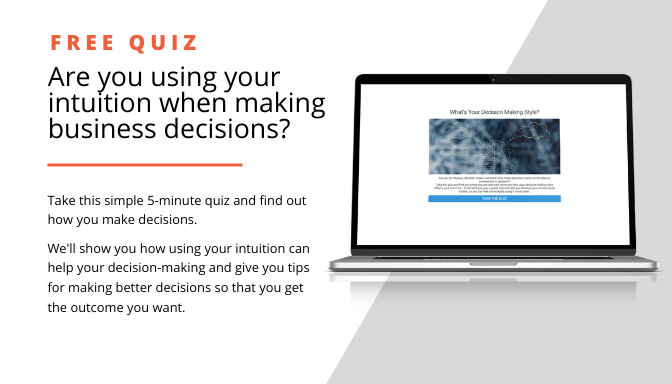Is there a way to make better decisions? You bet…decision making is something we do every single day, even if we don’t recognize them as decisions.
We all decide what time to get up in the morning when to leave for work, what we are going to eat for lunch if we are going to exercise…you get the point.
No matter what your position is in the workplace, you make decisions all day every day, at times without even thinking about it (putting a meeting on the calendar) and at other times distress over the decision. Let me start off by saying there is no perfect decision, nor is there a way to ensure you make the right decision all the time.
The right decision is the right decision then, at the moment, and there is always the possibility that it may need to change with circumstances.
So even if you make what you believe is the right decision now, you may find two weeks from now that it wasn’t as perfect a decision as you thought. It’s the nature of decision-making…things change.
However, there are some ways you can make better decisions and that’s what I’m covering here today.
7 Concepts That Will Help You to Make Better Decisions
#1: Eliminate Emotions
Some decisions have an emotional charge to them. You need to decide if you are going to terminate a poor-performing employee or someone who has done something unethical or questionable. Or you have to consider cutting costs, which may mean downsizing. Perhaps you have a client that is always difficult and you need to have a conversation that may result in you ending the relationship.
Conversely, you may be making a decision through the emotions of excitement and possibility, a new business opportunity is an example.
Whatever the situation, first check out your emotions. Are you angry, frustrated, perturbed, worried, anxious, or nervous? Are you super excited, starry-eyed, or in love with a concept?
Emotions will color your decision-making whether they are positive or negative emotions.
Before you make a decision I encourage you to check in with yourself and your emotions and, to the best of your ability, put your emotions aside before making the decision.
#2: Determine Your Risk Tolerance.
There are considerations related to real dollar costs that can’t be overlooked. Making a decision that, if you are incorrect, could cost the company $20 million dollars has a different risk associated with it than terminating a poor performer, even if you need them.
Each of us has a different tolerance for risk, determine what your tolerance level is before you go too far in the decision-making process.
#3: Remember no decision is a decision.
We overlook that ignoring a situation and not making a decision is a decision. So often I have clients tell me they aren’t ready to make a decision and assume that at some point in the future they will be ready. Today when they tell me they aren’t ready to make a decision they have made a decision; they made a decision to push off the timeline for making a decision.
There is nothing wrong with this approach, just don’t delude yourself into thinking that you aren’t making a decision because you haven’t finalized what the outcome will be. No decision today is still a decision.
#4: Quit waiting for all the information.
There is never a time when you will have enough information. If we had a crystal ball we could make the right decision all the time.
Great leaders understand that decisions need to be made and often they will not have all the information they need but will have enough information to make the decision. Enough information will vary between people and some are able to make decisions based on ‘gut’ while others want more facts.
I just caution you to consider while you are gathering all the facts, by the time you make the decision you may have lost an opportunity, or it may be too late.
#5: There is no perfect decision.
This goes along with point #3. There is no perfect decision. You have to weigh all the facts you have, depend on what your instincts tell you, and make the decision.
I often use the example of someone circling the pool checking the temperature of the water, making sure the 6-foot marker is actually 6 feet, checking around to see if anyone is watching them…just jump in the pool! You aren’t likely to drown and anything else is a bonus.
Be okay with knowing that there is no perfect decision.
#6: Retrospectively looking at a decision is not that helpful.
It’s absolutely true that if we knew today what we might know two weeks from now it would influence our decision today. Goes back to what I stated earlier — you can never have enough information and there is no perfect decision.
Evaluating a decision today that you made two weeks, two months, or two years ago isn’t that helpful unless you can determine something you missed at the time you made the decision. All kinds of things can change between today and tomorrow, let alone six months from now.
Beating yourself up for a decision you made in the past because now you have a set of different facts today, is unproductive.
#7: Include others when appropriate.
I often work with people who tell me that they are concerned about including others in their decision-making. Maybe it demonstrates weakness that they can’t decide on their own. Perhaps others will have better ideas and what does it say about them? What if they ask others and don’t take their advice?
And the list goes on as to why they don’t include others.
It doesn’t make sense to include others all the time, and at times it is completely appropriate, if for no other reason than we all get stuck in our own thinking.
Asking others for their input may open up our own thinking in a way you haven’t considered.
Decisions aren’t right or wrong.
Viewing them through that lens is a waste of your time. Some decisions may have better outcomes than others and that may or may not be because of you.
Timing, circumstances, and a whole host of other factors impact the outcomes of decisions.
The best thing you can do is go through the seven concepts I presented above and see where you are on the continuum related to each of them.
If you approach decisions considering the ideas I have presented it won’t guarantee a successful outcome, but it will help you get comfortable with decision making. The rest is up to you.









